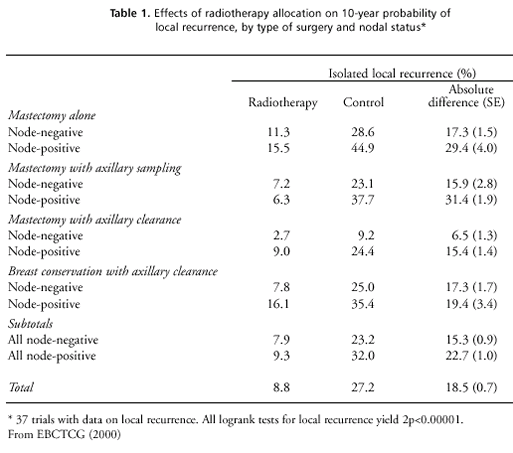|
 Home:
Educational Supplement: Appendix
Home:
Educational Supplement: Appendix
Overview:
Postmastectomy Radiotherapy
Jack
Cuzick, Ph.D.
The first issue
in cancer treatment to be addressed by a randomized trial was the
role of radiotherapy in breast cancer. Although that trial took
place in 1948, the question of whether radiotherapy is an appropriate
treatment for breast cancer remains controversial. There is little
doubt that radiotherapy is effective in improving local control
of the disease. The rate of local recurrence with radiotherapy is
reduced to about one-third of the rate when surgery alone is used,
although this absolute reduction is very much dependent on the extent
of the surgery and the nodal status of the patient (see table 1).
The relative reduction in local recurrence is substantial in all
trials and appears to be unaffected by patient age, nodal status,
dose, axillary or internal mammary chain irradiation, adjuvant chemotherapy
or tamoxifen, or time of trial commencement. Slightly better results
are seen in larger trials and also in trials employing smaller doses
of radiotherapy per fraction.
What is less
clear is the effect of radiotherapy on patient survival. This question
has been examined in five large studies since 1987. In the first,
Cuzick and colleagues observed an increase in late mortality (Cuzick,
Stewart, Peto, et al., 1987). A subsequent study (Cuzick, Stewart,
Rutqvist, et al., 1994) found that this increase was due to cardiovascular
mortality, but it also suggested that there might be a late reduction
in breast cancer deaths. Two subsequent and much larger overviews
have confirmed and extended these observations (EBCTCG, 1995; EBCTCG,
2000). The most recent study of radiotherapy involved the examination
of the deaths of more than 10,000 women out of a total of about
20,000 women in 40 randomized trials worldwide. No clear effect
of radiotherapy on total mortality was found, but the study found
highly significant differences in breast cancer deaths and non-breast-cancer
deaths (see figures 1 and 2). After 20 years of followup, breast
cancer deaths were reduced by 4.8 percent, but non-breast-cancer
deaths were elevated by 4.3 percent. Both of these changes were
highly significant (p< 0.001). The change in non-breast-cancer
deaths emerged later than the change in breast cancer deaths, the
differences being 1.0 percent for breast cancer mortality and 3.0
percent for non-breast-cancer mortality at 10 years. Most of the
excess non-breast-cancer deaths were due to vascular disease, which
increased by 30 percent. There were no significant subgroup effects
on the relative death rates from breast cancer and from non-breast-cancer
causes. However, an increased absolute death rate was seen in the
radiotherapy arm for older and for node-negative women, due to the
lower ratio of breast cancer deaths to other kinds of death in those
two groups. More recent trials have reported larger overall mortality
benefits from radiotherapy, but the followup from these trials is
shorter, so uncertainty remains about the long-term mortality effects,
especially for non-breast-cancer deaths.

Chief among
these uncertainties is whether the newer kinds of radiotherapy,
which allow for more accurate delivery of the dose, can achieve
reduction in breast cancer mortality without increasing cardiovascular
mortality. It will also be important to try to separate out the
effects of radiation of the breast/chest wall versus radiation of
lymph nodes. These questions are particularly relevant for women
with small tumors or ductal carcinoma in situ (DCIS) who receive
lumpectomy and radiotherapy, since their survival rate is very good
and deleterious late effects would be most damaging.
It is clear
that radiotherapy is of net benefit to patients who are at high
risk of local recurrence and is inappropriate for others where the
risk is low. Much uncertainty still exists about where to draw the
dividing line between these groups and the extent to which improved
techniques have shifted this boundary.
Preliminary
data from the next overview (to be published in September 2000)
will be available before the consensus development conference and
should cast additional light on these uncertainties.
References
Cuzick J, Stewart
H, Peto R, Baum M, Fisher B, Host H, et al. Overview of randomized
trials of postoperative adjuvant radiotherapy in breast cancer.
Cancer Treat Rep 1987;71:15-29. Abstract.
Cuzick J, Stewart
H, Rutqvist L, Houghton J, Edwards R, Redmond C, et al. Cause-specific
mortality in long-term survivors of breast cancer who participated
in trials of radiotherapy. J Clin Oncol 1994;12:447-53. Abstract.
Early Breast
Cancer Trialists’ Collaborative Group (EBCTCG). Effects of
radiotherapy and surgery in early breast cancer: an overview of
the randomized trials. N Engl J Med 1995;333:1444-55. Abstract.
Early Breast
Cancer Trialists’ Collaborative Group (EBCTCG). Favourable
and unfavourable effects on long-term survival of radiotherapy for
early breast cancer: an overview of the randomised trials. Lancet
2000;355:1757-70. Abstract.
|
|

